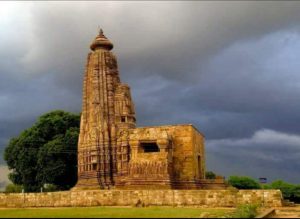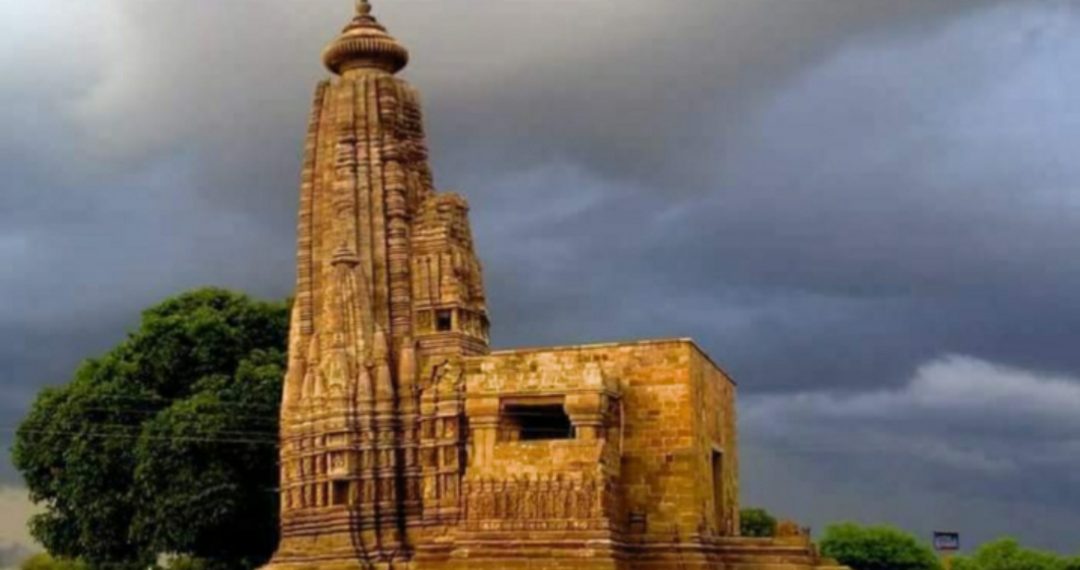WRITTEN BY DR. PANKAJ SHARMA | PHD, MPHIL NIS COACH | SHAHDOL, MP, INDIA
This temple is called Virat Mandir. It is said that the great city which is described during the unknown exile of the Pandavas in the Mahabharata is this Virat Nagar.

The emperor of this place was King Virat. Arjun Kund is located near Banganga in Himalayas. Shahdol’s former name is said to be Sahastra Dole. Wherever the rule of Kalchuri kings has been, they have built beautiful temples there.
The pavilion was seen to be rebuilt due to the collapse.
Care Taker reported that 70 years ago, the front of the temple was razed, which was repaired by the then Rewa King Gulab Singh. After that Thakur Sadhusinh and local area Lal Rajendrasinh also paid attention to the maintenance of the temple.
Now this temple is under the Archaeological Survey of India. The main entrance of the temple is exquisite in terms of craft. At the head of the main gateway, in the middle is the quadrilateral Vishnu Virajit. Veenavadini on the left and Ganesha are seated on the right side by kneeling. The sculpture of the temple is missing due to its fractal.
Shivalinga is installed in the sanctum sanctorum of the temple. The height of which will be about 8 inches and the aquarium is built and a copper phaninag is also seated on the Shivling. This temple is continuously worshiped. Some women were worshiping when I entered the sanctum sanctorum.
Amalak and Kalash are present on the top of the temple. Beautiful sculptures are placed on the outer reefs. Veenavadani on the wall on the right, Shankh, Chakra, Padma, Gadadhari Vishnu on the back wall and Brahma appear on the left side position.
Also, Nandiraj, Gandivadhari Pratincha, Arjuna, Umamaheshwar, Ganapati in Varada Mudra and different types of disambiguation are also seen in Sthanak Mudra.
This temple is also rich in terms of marking of Gemini statues. Frantic protagonists display various rugs of heroine Kamakala.
Seeing these kamkali rugs, I am surprised that Kali used to play kamali as a sport. Here a bearded man is seen with a mating woman.
This shows that this place must have been famous for Shaivism also. Methunrat man shown in the statues is Kapalik. Kapalik Vamargi are Tantric. They wear Pancha Makaras – Madan, Meat, Meen, Mudran, Maithun and Ch. Aite Panchamakara: Syormoxade Yuge Yuge.
Kapalik belief is that just as the four Vedas came out of the mouth of Brahma, similarly Tantra originated from Shrimukh of Bhole Bhandari. That is why Kapalik Shaivopasana.
According to the known history, according to the Untivatika Tamralekh, the eastern part of the district, especially the area around Sohagpur, was in the possession of Rashtrakuta dynasty king Abhimanyu of a place called Manpur in about seventh century.
In the Bhopal inscription of Udaya Varma, there is a mention of donation of Gunaura of village Narmadapur revivalist in Vindhya Mandal in 1199 AD. From this and the Harsud inscription of Devpal Dev (AD 1208), it is mentioned that the central and western parts of the district had the right of the kings of Dhar.
The remaining princely states in the Seoni-Malwa Hoshangabad and Sohagpur tehsils located east of Ganjal gradually became the authority of Bhonsala Raja of Nagpur between 1740 and 1755 AD.
In 1796, his Subedar Benisingh of Bhanwargarh also took control of the fort of Hoshangabad. From 1802 to 1808, Hoshangabad and Seoni were occupied by the Nawabs of Bhopal, but in 1808 the Bhonsala Raja of Nagpur finally regained it.
In the last English-Maratha war of 1817, the British took control of Hoshangabad and were subjected to a temporary agreement made by Appa Saheb Bhonsla in 1818.
In 1820, the districts offered by Bhonsala and Peshwa were consolidated under the name of Sagar, and the Narmada Territory, and were placed under the agent of the Governor General, who lived in Jabalpur.
At that time, Hoshangabad district included the area from Sohagpur to Ganjal river and Harda and Handia were near Scindia.
From 1835 to 1842, Hoshangabad, Betul and Narsinghpur districts were included together, and their headquarters was Hoshangabad. As a result of the Bundela Rebellion of 1842, they were again divided into three districts as before.
Several chhatris (deceased memorials) appear to be built around this temple.
The temple’s mandapa houses several statues obtained from other places. Which includes the Buddha statue of Padmasana. The temple’s establishment has also been destroyed.
Its protection continued. Visiting the Virat temple made the mind happy.
Virat Mandir, symbol of Kalchurian pride, is proudly staring at the sky even after thousands of years have passed. If its conservation is not done in a proper way, then it can be found in the dust of historic dust.
मंदिर को विराट मंदिर कहा जाता है। कहते हैं कि महाभारत में पांडवों के अज्ञातवास के दौरान जिस विराट नगर का वर्णन है वह यही विराट नगर है।
यहाँ के सम्राट राजा विराट थे। समीप ही बाणगंगा में पाताल तोड़ अर्जुन कुंड स्थित है। शहडोल का पूर्व नाम सहस्त्र डोल बताया जाता है। कलचुरी राजाओं का राज जहाँ भी रहा उन्होने वहाँ सुंदर मंदिरों का निर्माण कराया है।
मंडप ढहने के कारण पुन: निर्मित दिखाई दे रहा था।
केयर टेकर ने बताया कि 70 साल पहले मंदिर के सामने का हिस्सा धराशायी हो गया था, जिसे तत्कालीन रीवा नरेश गुलाबसिंह ने ठीक कराया था। उसके बाद ठाकुर साधूसिंह और इलाकेदार लाल राजेन्द्रसिंह ने भी मंदिर की देखरेख पर ध्यान दिया।
अब यह मंदिर भारतीय पुरातत्व सर्वेक्षण के अधीन है। मंदिर का मुख्य द्वार शिल्प की दृष्टि से उत्तम है। मुख्यद्वार के सिरदल पर मध्य में चतुर्भुजी विष्णु विराजित हैं। बांई ओर वीणावादिनी एवं दांई ओर बांया घुटना मोड़ कर बैठे हुए गणेश जी स्थापित हैं। मंदिर का वितान भग्न होने के कारण उसमें बनाई गई शिल्पकारी गायब है।
मन्दिर के गर्भ गृह में शिवलिंग स्थापित है। जिसकी ऊंचाई लगभग 8 इंच होगी तथा जलहरी निर्मित है एवं तांबे के एक फ़णीनाग भी शिवलिंग पर विराजित हैं। यह मंदिर सतत पूजित है। जब मैने गर्भ गृह में प्रवेश किया तो कुछ महिलाएं पूजा कर रही थी।
मंदिर के शिखर पर आमलक एवं कलश मौजूद है। बाहरी भित्तियों पर सुंदर प्रतिमाएं लगी हुई है। दांई ओर की दीवाल पर वीणावादनी, पीछे की भित्ती पर शंख, चक्र, पद्म, गदाधारी विष्णु तथा बांई ओर स्थानक मुद्रा में ब्रम्हा दिखाई देते हैं।
साथ ही स्थानक मुद्रा में नंदीराज, गांडीवधारी प्रत्यंचा चढाए अर्जुन, उमामहेश्वर, वरद मुद्रा में गणपति तथा विभिन्न तरह का व्यालांकन भी दिखाई देता है।
मिथुन मूर्तियों के अंकन की दृष्टि से भी यह मंदिर समृद्ध है। उन्मत्त नायक नायिका कामकला के विभिन्न आसनों को प्रदर्शित करते हैं।
इन कामकेलि आसनों को देख कर मुझे आश्चर्य होता है कि काम को क्रीड़ा के रुप में लेकर उन्मुक्त केलि की जाती थी। यहाँ मैथुनरत स्त्री के साथ दाढी वाला पुरुष दिखाई देता है।
इससे जाहिर होता है कि यह स्थान शैव तंत्र के लिए भी प्रसिद्ध रहा होगा। प्रतिमाओं में प्रदर्शित मैथुनरत पुरुष कापालिक है। कापालिक वाममार्गी तांत्रिक होते हैं। वे पंच मकारों को धारण करते हैं – मद्यं, मांसं, मीनं, मुद्रां, मैथुनं एव च। ऐते पंचमकार: स्योर्मोक्षदे युगे युगे।
कापालिक मान्यता है कि जिस तरह ब्रह्मा के मुख से चार वेद निकले, उसी तरह तंत्र की उत्पत्ति भोले भंडारी के श्रीमुख से हुई। इसलिए कापालिक शैवोपासना करते हैं।
ज्ञात इतिहास के अनुसार उन्तिवाटिका ताम्रलेख के अनुसार जिला का पूर्वी भाग, विशेषकर सोहागपुर के आसपास का भाग लगभग सातवी शताब्दी में मानपुर नामक स्थान के राष्ट्रकूट वंशीय राजा अभिमन्यु के अधिकार में था ।
उदय वर्मा के भोपाल शिलालेख में ई. सन् 1199 में विन्ध्य मंडल में नर्मदापुर प्रतिजागरणक के ग्राम गुनौरा के दान में दिये जाने का उल्लेख है. इससे तथा देवपाल देव (ई. सन् 1208) के हरसूद शिलालेख से यह पता उल्लेख है कि जिले के मध्य तथा पश्चिमी भागों पर धार के राजाओं का अधिकार था ।
गंजाल के पूर्व में स्थित सिवनी-मालवा होशंगाबाद तथा सोहागपुर तहसीलों में आने वाली शेष रियासतों पर धीरे-धीरे ई.सन् 1740 तथा 1755 के मध्य नागपुर के भोंसला राजा का अधिकार होता गया ।
भंवरगढ़ के उसके सूबेदार बेनीसिंह ने 1796 में होशंगाबाद के किले पर भी अधिकार कर लिया. 1802 से 1808 तक होशंगाबाद तथा सिवनी पर भोपाल के नबाव का अधिकार हो गया, किंतु 1808 में नागपुर के भोंसला राजा ने अंतत: उस पर पुन: अधिकार कर लिया।
वर्ष 1817 के अंतिम अंग्रेज-मराठा युध्द में होशंगाबाद पर अंग्रेजों का अधिकार हो गया तथा उसे सन् 1818 में अप्पा साहेब भोंसला द्वारा किए गए अस्थायी करार के अधीन रखा गया।
सन् 1820 में भोंसला तथा पेशवा द्वारा अर्पित जिले सागर, तथा नर्मदा भू-भाग के नाम से समेकित कर दिए गए तथा उन्हें गवर्नर जनरल के एजेंट के अधीन रखा गया, जो जबलपुर में रहता था।
उस समय होशंगाबाद जिले में सोहागपुर से लेकर गंजाल नदी तक का क्षेत्र सम्मिलित था तथा हरदा और हंडिया सिंधिया के पास थे।
सन् 1835 से 1842 तक होशंगाबाद, बैतूल तथा नरसिंहपुर जिले एक साथ सम्मिलित थे, और उनका मुख्यालय होशंगाबाद था. 1842 के बुंदेला विद्रोह के परिणाम स्वरूप उन्हें पहले की तरह पुन: तीन जिलों में विभक्त कर दिया गया।
इस मंदिर के आस पास कई छतरियाँ (मृतक स्मारक) बनी दिखाई देती हैं।
मंदिर के मंडप में अन्य स्थानों से प्राप्त कई प्रतिमाएं रखी हुई हैं। जिनमें पद्मासनस्थ बुद्ध की मूर्ति भी सम्मिलित है। मंदिर का अधिष्ठान भी क्षरित हो चुका है।
इसका सरंक्षण जारी दिखाई दिया। विराट मंदिर के दर्शन करके मन प्रसन्न हो गया।
कलचुरीकालीन गौरव का प्रतीक विराट मंदिर सहस्त्र वर्ष बीत जाने पर भी गर्व से सीना तानकर आसमान से टक्कर ले रहा है। अगर इसका संरक्षण कार्य ढंग से नहीं हुआ तो यह ऐतिहासिक धरोधर धूल में मिल सकती है
All information entered is personal to the author. Any modification or changes must be addressed to the author.







